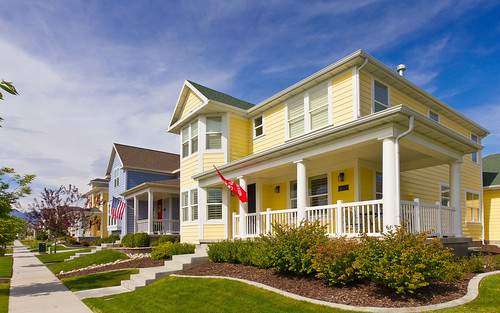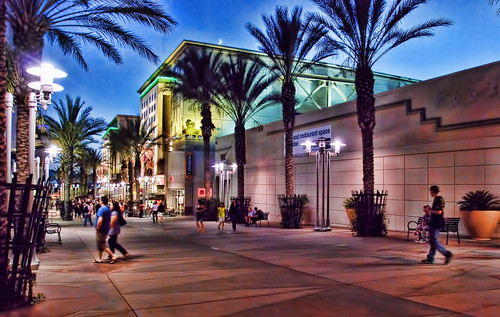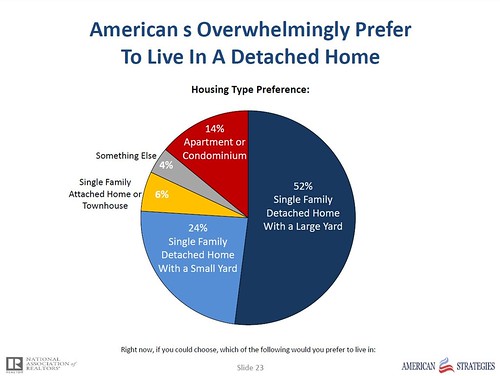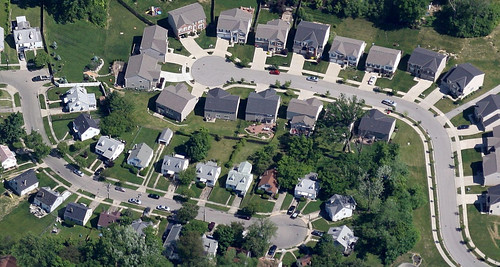New Realtors' community preference poll: Americans want to have their cake and eat it, too

Posted November 25, 2013 at 1:26PM
The latest national community preference survey, conducted periodically by the National Association of Realtors, was released earlier this month. The results are all over the place. Looking for evidence to support reported trends toward smart growth living in walkable, mixed use neighborhoods? You’ll find it in the poll. But, if you’re a smart growth skeptic who believes Americans still prefer conventional suburban development with large lots, you’ll find plenty of evidence for that, too.
Results favoring smart growth
The good news for smart growth advocates is that, while jobs, education, crime and health care dominate the issues of top concern for Americans, clear majorities believe that certain elements of the smart growth and sustainability agenda should be “extremely high” or “high” priorities for their state governments. These include improving the availability of affordable housing (59 percent either “extremely high” or “high” priority), protecting the environment (57 percent), and preserving farms and open spaces from development (54 percent). The portion of respondents concerned about affordable housing was up eight percent from the results of a similar poll two years ago.
Nearly half of those surveyed place a high or extremely high priority also on revitalizing cities (47 percent), reducing traffic congestion (47 percent), and providing convenient alternatives to driving (46 percent). Significantly, revitalizing cities is a significantly higher priority than creating new development outside of cities (37 percent). Supporting alternatives to driving drew clear majorities of certain demographic groups, including non-whites, urban residents, and those under age 50.
Walkable, mixed-use communities fared particularly well in the survey. Asked to choose among six community types to describe where “would you most like to live,” a majority of respondents indicated a preference for living in suburbs or rural areas (combined 57 percent). But, among those preferring suburban living, nearly three times as many prefer a neighborhood “with a mix of houses, shops and businesses” as prefer a residential-only neighborhood (30 percent versus 11 percent).
Americans are mostly satisfied with where they currently live, but nearly half believe their communities have too little affordable housing, lack public transportation within an easy walk, and lack safe routes for riding bikes to work and shopping. A majority of older Americans (but a lower portion of all Americans) believe their communities do not have enough shops or restaurants within an easy walk of their homes. Twenty-eight percent believe their communities have “too much” high-income housing.
Strong majorities of Americans would prefer a neighborhood with shops and businesses that are easy to walk to (60 percent), even if it means having small yards (55 percent). Respondents also would prefer neighborhoods with small yards if it meant a shorter commute to work (57 percent). Given a description of a walkable, mixed-use community and a conventional suburban community, respondents’ preferences were split fairly evenly, a slim majority preferring the walkable, mixed-use community (50 percent to 45 percent).
Even those who prefer a conventional suburban community would like to see “places such as shopping, restaurants, a library, and a school within a few blocks” (54 percent of those favoring suburban living). Among all respondents, over two-thirds rated “being within an easy walk of other places and things” as very or somewhat important (69 percent). The portion rating walkability as “very” important has increased since the 2011 survey, as has being in a mixed-age community.
Among transportation issues, the portion of Americans who believe that maintaining local streets and roads is extremely or very important is far greater than that giving high ratings to expanding highways (84 percent versus 52 percent). Asked to choose among three options as “the best long term solution to reducing traffic and improving transportation,” only 20 percent favored building new roads, as opposed to 41 percent favoring improved public transportation and 29 percent preferring to develop communities “where people do not have to drive long distances to work or shop.”
Forty percent of infrequent public transit users would take transit more often if service were more frequent and faster.
Results favoring conventional suburban development
While Americans increasingly favor communities with walkable convenience to shops and amenities, we remain a nation that prefers suburban living and its attributes. Even 42 percent of city dwellers say they would prefer to live in a suburb or rural area, while very few suburbanites would prefer to live in a city (12 percent). A full 52 percent of Americans prefer to live in a single-family, detached home with a large yard, as opposed to 24 percent who prefer the same type of home with a small yard. Only 14 percent prefer an apartment or condominium.
Large yards are especially important to “moms” and women under 50. Even among all respondents who prefer city living, over twice as many prefer a large yard to a small one (48 percent to 22 percent).
The preference for detached, single-family homes is so strong that 57 percent of Americans prefer them to apartments or townhouses even if they would “have to drive to shops and restaurants and have a longer commute to work.” (The portion of those listing a short commute as “very” important actually declined by eight percentage points from 2011 to 2013.) Among those who prefer conventional suburban living, nearly half chose “there are only single family houses” as the single most important characteristic (48 percent). (These findings seem to directly conflict with other findings in the survey, when questions were asked in a slightly different way.)
A whopping 86 percent of Americans list “privacy from neighbors” as very or somewhat important in deciding where to live. A majority list “living in a place that’s away from it all” as very or somewhat important (55 percent). A majority also values “being able to buy as large a house as you can” (51 percent). Unsurprisingly, high-quality public schools also are considered very or somewhat important by a large majority of Americans (74 percent).
I suppose it also is not surprising that high-quality public schools is of higher importance to younger Americans (18-40) than to older ones (over 50), though the size of the margin (51 to 36 percent) surprised me. And I was quite surprised that younger Americans strongly outpolled older ones in the importance of “being able to buy a house as large as you can” (26 to 11 percent) and “having a large house (26 to 9 percent).
The poll confirms that Americans still love their cars. A strong majority agrees with the statement, “For me, car is king. Nothing will replace my car as my main mode of transportation” (57 percent). Less than a quarter (22 percent) disagree with the statement. Among those who prefer conventional suburbs, over a third list limited parking as the least appealing characteristic of more walkable communities (36 percent). Indeed, parking is most often listed even by those who prefer walkable communities as the most appealing characteristic of conventional suburban communities (selected by 33 percent).
What to make of all this
It’s not easy to take a single consistent set of messages from this survey. The evidence appears clear that Americans value convenience and walkability, but also large yards, privacy from neighbors, and travel by car. Is it possible to have all that in the same community? To me, the poll suggests that figuring out how close we can get to supplying a diversity of housing and lifestyle choices in the same community may be key to the success of a sustainability agenda. Privacy from neighbors, in particular, seems so important to Americans that those of us who favor walkable neighborhoods should devote additional resources to designing solutions that supply it in less sprawling forms than we have now.
I was also struck by the relative importance of land use issues in the survey. People consider jobs, health, and crime most important but, among land use issues, those that most resonated with the poll respondents were affordable housing, environmental protection, and preserving farmland and open space. The current smart growth agenda as actually practiced, particularly on the national level, is in my opinion a bit out of step with these concerns. We focus primarily on promoting high-density development and transportation, which address these higher-polling issues indirectly, but we don’t address them much directly.
Lee Epstein and I have written about this before. I don’t know that there should be a major change in the agenda, but the poll suggests that we might be well served by shifting more resources into such goals as affordability and equity; explicit environmental issues such as water quality; and land conservation.
The high polling for driving and parking in the poll further suggests that at least those portions of the smart growth movement who prefer a non-adversary approach to advocacy should be very careful about anti-car, anti-parking rhetoric. It is hard to argue against the proposition that we have built our cities and suburbs far too much around cars for several decades and that it is time to shift back to people and more transportation choices. But, to earn the support of public opinion, this set of issues must be approached very carefully in most American communities. (See my post from last week on “driving-optional neighborhoods.”)
Finally, the poll seems to confirm that (apart from the preference for larger houses) the trend among younger Americans is toward a set of values highly compatible with the smart growth agenda. Much more than over-50 respondents, younger Americans 18-40 prefer being within a short commute to work; a community with people at all stages of life; a community with a mix of people from various ethnic and racial backgrounds; and living in a place that’s “at the center of it all.” As a cautionary note, however, 51 percent of younger Americans still agree with the statement that “nothing will replace my car as my main mode of transportation.” Only 26 percent disagree with the statement.
The national internet survey was conducted in September by the polling firm American Strategies and reached 1,500 adults, 18 years or older.
Related posts:
- Poll shows that Americans like planning, after all. But the details are messy. (June 18, 2012)
- Industry study: Americans want smart growth (April 7, 2011)
- Industry survey confirms developers shifting to smart growth (October 6, 2010)
- Poll finds overwhelming US support for improved public transportation – slideshow summary (April 7, 2010)
Move your cursor over the images for credit information.
.



